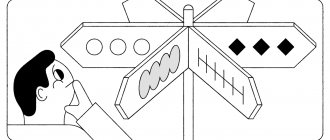What are sleep disorders and how do they manifest?
Young children often suffer from sleep disorders - approximately 15% of babies have difficulty falling asleep or wake up at night, not allowing their parents to rest. Sleep pathologies are called insomnia, experts divide them into two types - primary (occur as an independent problem) and secondary (develop against the background of other diseases, for example, neurological). Primary sleep disorders are most often behavioral, that is, associated with behavior during the period of falling asleep, improper organization of falling asleep. They do not cause problems with the child’s health and do not affect his well-being, that is, they create more difficulties for parents than for children. Secondary insomnia is a manifestation of various diseases, leading to the fact that the baby cannot rest properly, and this affects his development and learning.
You should see a doctor if your child:
• Suffering from insomnia - cannot fall asleep for more than three hours, sleeps less than six hours at night, clearly does not get enough sleep, becomes restless, irritable or, conversely, lethargic and apathetic. • Snores, breathes through the mouth during sleep, has difficulty breathing, or has periods of apnea (nighttime cessation of breathing). • Grinding teeth. • Sleeps extremely restlessly, suffers from sleepwalking.
Reason No. 5. Malaise
It happens that crying is associated with a certain ailment of the baby (intracranial pressure, nervous system disorders, increased excitability, hypertonicity, hypotonicity, developmental pathology, physiological phenomena of the adaptation period, the onset of an infectious or cold disease, skin diseases or diaper rash, reaction to geomagnetic, atmospheric phenomena and etc.). If you cannot identify the reason for your baby’s crying, do not hesitate to consult a perinatologist: the doctor will definitely help eliminate crying associated with the disease.
Behavioral sleep disorders
Behavioral sleep disorders are most often associated with disruption of sleep associations. Thus, some children fall asleep only in the presence of their parents, while an adult must be nearby for several hours. Or, waking up at night, the baby cannot fall asleep without motion sickness. Incorrect associations also include sucking a pacifier, finger, touching an adult’s hand, etc. Having woken up and discovered that conditions have changed, the child will scream to demand the return of the usual environment. To avoid such situations, parents need to develop a falling asleep ritual, which, repeated daily from a very early age, will contribute to the formation of the correct associations.
In older children, behavioral disorders may manifest themselves in the form of a long time to fall asleep, tantrums before bed, and a desire to keep adults nearby (for example, the child asks to go to the toilet or drink several times during the evening). Or children often wake up at night and come to their parents’ bed.
Reason #2: I'm uncomfortable
Children often cry because they feel uncomfortable. This kind of crying is continuous (or almost continuous), more monotonous compared to crying from hunger and is accompanied by anxiety in the child. Which can cause discomfort in a newborn
- Dirty diaper or wet diaper. In the first month of life, a baby “goes to the toilet” up to 20 times a day. With natural feeding, the child’s stool frequency is 5–6 times, and with artificial feeding — 3–4 times a day;
- Need to change position: the baby wants to roll over, and he needs your help; he will learn to roll over on his own only after a few months;
- Too tight swaddling, tight diaper, folds in diapers, small object caught in diaper or clothing (button, crumb, pebble, string);
- Too bright lighting, loud noise, not enough fresh air;
- Intestinal colic.
Tight swaddling (with straightened legs and straightened arms tightly pressed to the body), which was very common before, disrupts the natural position of the newborn, normal breathing and blood circulation, which the child “does not like.”
How to help your child fall asleep?
A child falls asleep well if he has formed the right associations - they are created using a certain falling asleep ritual. This may include bathing, evening reading, a short stay of one of the parents in the children's room, hugs and kisses before bed. Do not use motion sickness, bottle feeding, or prolonged carrying.
The scheme for falling asleep looks like this - the child is put to bed in a state of wakefulness, then the parents must adhere to the chosen ritual. That is, they can read to the baby, sit with him for a while, hug and kiss him, etc. Then the adults leave the room to give the child the opportunity to fall asleep on his own. Something with a mother's scent in the crib will help babies fall asleep, and older children can use a favorite toy. This approach will help you avoid sleep problems in older age.
The child will fall asleep better and sleep more soundly if he is comfortable. The baby should have comfortable pajamas and high-quality bed linen, the room must be maintained at an optimal temperature, and the room must be ventilated.
Correct daily routine
From an early age, a child must understand the difference between night and daytime, they need to be clearly separated - in the evening it is better to dim the lights, talk quietly, calmly, and exclude active games. This will help you get ready for sleep. When waking up at night, you should limit communication with your child, do not play with him, and do not turn on the light.
It is very important to adhere to the daily routine - gradually the baby will get used to going to bed at the same hours and will feel tired at the right time. “Life by the clock” creates a feeling of security; the child gets used to a certain routine, as a result he is less capricious and falls asleep faster. It is necessary to determine the optimal time for daytime and night sleep; you should not let children sleep too long during the day, otherwise they will not have time to get tired before the night's rest.
Most often, sleep problems occur in children whose parents put them to bed not according to the clock, but every day at different times, waiting until they are tired. Or in children who face frequent violations of the regime, for example, parents send them to bed at one time, and grandmothers at another, allowing their beloved grandchildren to play longer than expected.
Neighbours…
But a baby’s tantrum before bedtime is especially exhausting for parents. They become powerless in front of a crying child whom they are trying to put to sleep. Especially if there are neighbors behind the wall. I’m lucky - we live in a private house and I’m not ashamed in front of my neighbors because they don’t hear anything.
In an apartment, of course, it is more difficult. But, nevertheless, the calmer you behave, the faster this period will pass. And you can simply talk to your neighbors in a friendly manner: “Are we disturbing you too much?” Share that you are going through a difficult period, that you are cutting teeth or something else.
Why am I so worried about my neighbors, you ask?
More than once I have read negative posts on forums from neighbors who do not yet have children or who have already forgotten what crybabies are like at this age. Their messages on the forums are angry with the child or with the parents, some are too worried about what is happening to the child, to the point of asking the forum members: “maybe you need to call the police”... Therefore, I think it’s better to talk to them and “relax situation”, make it clear that you are an adequate person and that you understand everything.
Getting up while sleeping - what to do?
When a child wakes up at night and cries, it is not necessary to immediately pick him up - as a rule, it is enough to go over to check if everything is okay and calm the baby down in a gentle tone. It is not recommended to feed children older than six months at night; instead of formula or breastfeeding, it is better to give plain water to drink. If a child is used to eating in his sleep, you should try to wean him from this habit by gradually lengthening the interval between feedings, giving a more diluted mixture, replacing it with baby tea or warmed water.
When a child jumps up immediately after going to bed and asks for a drink or to play, you need to calmly give the baby something to drink or take him to the toilet and send him back to bed. You should not stay in the children's room, entertain the children, or allow them to play - otherwise such rises will become a habit. In such situations, they act calmly, affectionately, but firmly explaining that it is time to sleep and, therefore, it is necessary to lie in your crib.
Children after three years of age often wake up from nightmares. Night fears cannot be ignored; you must calm the child down and, if necessary, sit with him until he falls asleep again. In order to avoid disturbing dreams, it is worth limiting strong impressions in the afternoon, not showing your child cartoons with aggressive plots and harsh sound effects before bedtime, and organizing the time before falling asleep so that the child has time to calm down before going to bed.
Parents need to understand that behavioral sleep disorders can be easily corrected by properly organizing the daily routine. But, if a child does not sleep due to health problems, only a doctor can help. It is important to recognize a violation in time, requiring consultation with a specialist.
Parasomnias: night tantrums and sleepwalking
12.08.2016
120
The baby suddenly “wakes up” and screams in his sleep the terrible words “Don’t touch me, move away!”, “Stop it now!”, “Disappear, please, disappear!”, he does not respond to his mother’s calls and persuasion, and continues to cry terribly. His eyes are open, his forehead is covered with sweat, the child is not himself. This horror can last from several minutes to half an hour.
Here is an example of a parasomnia called “night terror”. Anyone who has ever experienced nighttime hysteria will never forget it.
Parasomnia - what is it?
Human sleep is not just the absence of wakefulness, it is a whole world, a system organized in a special way. This system is controlled by the brain and subjugates the entire body during sleep. Even in an adult, sleep and wakefulness may not completely transform into each other. In a child, especially in the first months of his life, when the sleep phases are not yet fully formed, they sometimes appear at the “wrong time” or even overlap one another. At moments of such “superposition of phases” the body behaves in an unusual way - a person can walk, talk, move his arms and legs, or even cry bitterly, while continuing to sleep soundly. Such phenomena of activity during deep sleep are called parasomnia (from para - disturbance and somnus - sleep).
Parasomnia is not a pathology, but simply a consequence of general immaturity of the brain. Over time, this “superposition of phases” occurs less and less often, and by adolescence it usually goes away completely.
Well, perhaps leaving behind as a “memory” the ability to talk in your sleep.
Parasomnias in themselves do not pose a health hazard, however, they can add anxiety and worry to parents. The best way to terrify parents is with such manifestations of parasomnia as nighttime hysterics and sleepwalking. Here we will dwell on them in more detail.
Night tantrums. Why does a child cry in his sleep?
Let's immediately differentiate the terms so as not to be confused further. There are many articles about children's sleep, but the terminology used is different. So, there are terrible unpleasant dreams. We all see them sometimes at night, but they have nothing to do with what we would call night tantrums, or nightmares/fears. The nature of night hysterics is very different from the nature of ordinary dreams; below we will look at and analyze the main differences.
Most often, nighttime tantrums occur in children between one and five years of age. Night tantrums (in English-language sources “night terror”) are attacks of severe fear, usually accompanied by crying or screaming, that occur when one phase of sleep is superimposed on another.
Anyone who has ever encountered this phenomenon knows that it is really very scary. The child is desperately screaming, talking, his eyes are wide open, but he doesn’t seem to see you, his forehead is covered with perspiration. You can feel how hard his heart is beating and how hard he is breathing. It is almost impossible to calm the baby down; he does not respond to persuasion, and does not allow himself to be hugged or pulled out of the crib.
And really, there is no need to try to do this.
Although your baby may appear to be awake, he or she is actually in a deep sleep stage. An attack of night hysteria can last from several minutes to half an hour.
What is the main difference between night hysterics and terrible dreams?
Scary dreams, like any other dreams, occur during the rapid eye movement phase. During this phase, the body is asleep, but the brain works much the same as in wakefulness. Sleep is sensitive at this time, a child who has had a nightmare can quickly wake up, he remembers what scared him, and your gentle hands, hugs, and rocking will help him calm down.
This is not the case with an episode of nighttime hysteria. Night tantrums usually occur at the beginning of the night, when the phases of deep sleep prevail, during which a person sleeps without dreams. The child suddenly experiences a strong feeling of fear, his brain tries to wake up, but at the same time continues to sleep soundly. As a result, the baby screams and cries, but it will not be possible to correct the situation with persuasion or affection - even though the baby’s eyes are open, he is sleeping and does not see you.
A child who has experienced a night tantrum will not remember anything after waking up. Therefore, if you want to talk to him about what happened, your questions should be constructed only in the form of open questions that do not offer a choice of two or three options and cannot be answered “yes” or “no.”
Let's clarify why you can't “guess.” Imagine: the baby finally woke up from a night of hysterics, remembers nothing except that he slept soundly in his bed. And then a frightened crowd stands in front of him: a neighbor with a valerian, an older sister, and his mother asks in tears: “Darling, did you dream that a shark was chasing you or how your mother left and did not return?” Put yourself in the child's shoes. Here you confess to anything, as long as everyone leaves and stops asking strange questions. But the baby will definitely have doubts that everything is fine.
It's best to ask questions like, "What do you remember?" or “What did you dream?”, so as not to impose your vision of what happened on the child. And then, such questions can be asked once to make sure that this was really an episode of parasomnia, “night terror”. The calmer and less intrusive you ask your baby about what happened, the less likely it is to scare him.
So what to do about nighttime tantrums?
First of all, it is necessary to exclude the possibility of neurological causes of what is happening. Consult your doctor. If the doctor says that your baby is healthy and does not need treatment, then you should behave as follows during night hysterics:
- As already mentioned, do not try to wake the child - you will only disturb him more.
- Dim the lights, sit next to him, but do not try to take the baby out of the crib or cuddle him. Make sure that the child does not injure himself if he jerks his arms or legs sharply. You can hum softly or say something soothing to him.
- The most important thing that needs to be done to prevent night hysterics in the future is to monitor the child’s routine, avoid excessive partying or lack of sleep, and avoid stress and overexcitement.
- Be sure to keep a diary where you write down what time your baby went to bed on the day the night tantrum occurred, and what time the episode began. On the following nights, you can wake up the baby for a second half an hour before the expected start of the hysteria with a gentle hug and kiss, this will knock him out of sleep. Often this method helps to avoid nighttime hysteria. This work must be done within two weeks and then try to see if it was possible to restart the system as a whole. Of course, all this time it is important to put the baby to bed early, offer naps during the day, and avoid noisy events and unusual trips.
- Pay attention to the crib: it should be as safe as possible. Take special care to ensure the safety of the sleeping area so that your baby can't hurt himself or herself when he flails his arms and legs in his sleep.
Night tantrums usually go away as people get older, but in some cases they can return during adolescence. Be prepared for this and warn your child that this can happen.
It is also worth paying your attention to whether your relatives experienced parasomnias in childhood. This often means that this can also happen to your baby - the causes of parasomnia have genetic roots. Moreover, if one of the relatives had one type of parasomnia, his child may develop another. For example, a grandmother had night hysterics, and her grandson may have sleepwalking.
What to do to make your baby sleep?
MARATHON
Let's take the first steps together in the topic of children's sleep
More details
Sleepwalking
Studies have shown that 5% of children aged 6 to 16 years experienced sleepwalking up to 12 times a year. And another 10% had episodes of sleepwalking every 3-4 months. Modern science believes that sleepwalking is not associated with emotional stress or behavioral problems, and its causes lie in a hereditary predisposition. Cases of sleepwalking usually occur 2-3 hours after falling asleep, and last up to half an hour. If you look at the sleepwalker at this time, it seems that he does not quite understand where he is. His gait is devoid of smoothness, and his movements seem to be aimless. During episodes of sleepwalking, the child can not only walk, but also get dressed, open doors and windows, and even eat! The problem does not require treatment, however, certain safety measures should be taken. Make sure that your baby (or husband) cannot open the front door or window in a dream: place the door lock or chain so high that the child cannot reach it, put special handles with a lock on the windows. It is also worth removing toys and furniture with hard corners from the path of a sleeping child.
Contrary to popular belief, waking a person during an episode of sleepwalking is not dangerous, however, it is worth remembering that during the awakening he will be completely disoriented and may fall or crash into some objects.
Sleepwalking usually goes away on its own by adolescence.
Have you ever encountered nightly hysterics and sleepwalking? Write in the comments below.
Did you like the article? Rate:
Votes: 183










